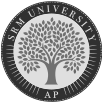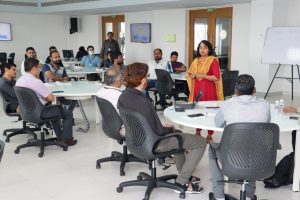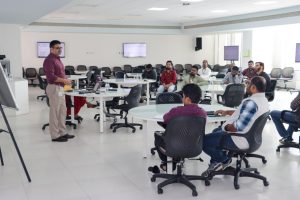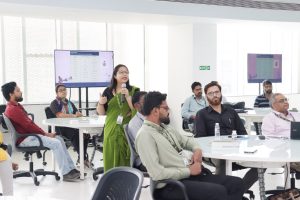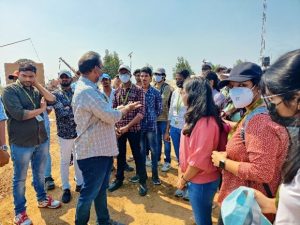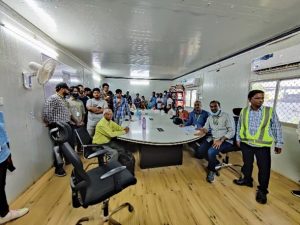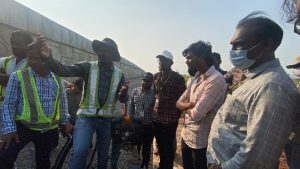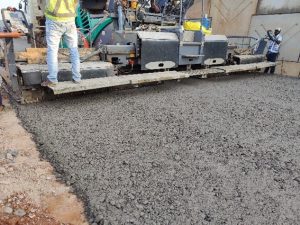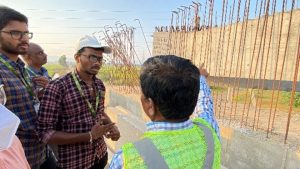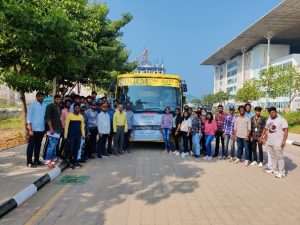SRM-AP All News
ALL News
- Faculty Orientation Programme 2023 January 30, 2023
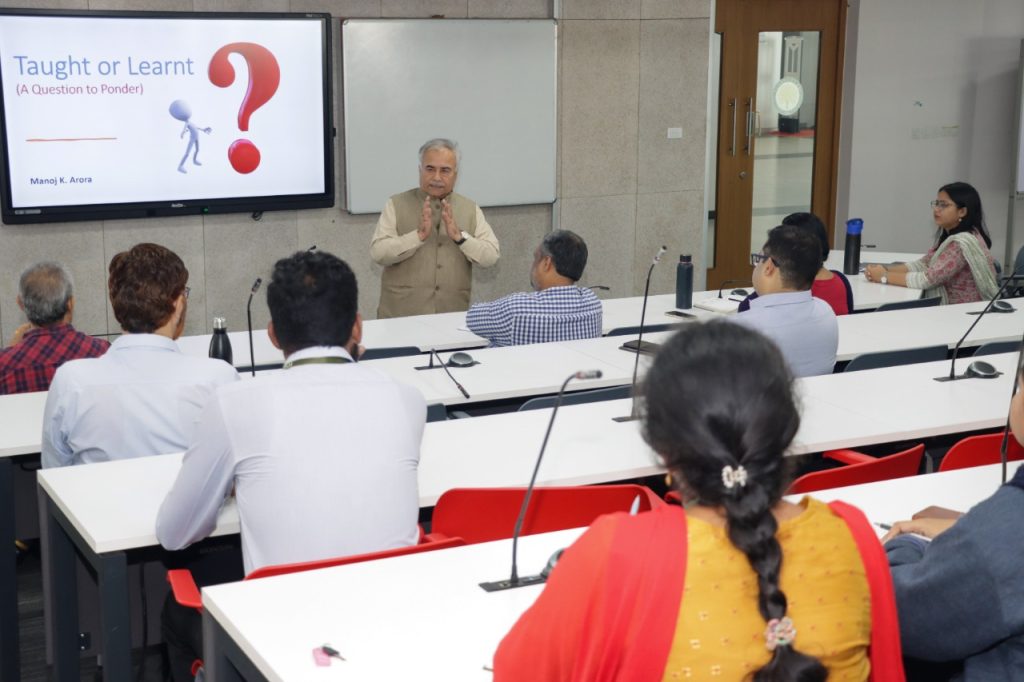
The Teaching Learning Centre at SRM University-AP conducted a 4-day face-to-face Faculty Orientation programme for the newly joined faculty members from January 17 – 20, 2023. Honourable Vice Chancellor, Prof. Manoj K Arora delivered an introductory talk expounding on the larger goals of the University. The programme aimed at seamlessly aligning faculty activities with the University’s ideology & philosophy.
The workshop included a series of hands-on sessions on Active Learning, Project Based Learning, Technology-enabled learning, Outcome-based learning, Curriculum design, development and delivery, new ways of assessments, Classroom communication and Student engagement facilitated by Dr Balaguruprasad N and Dr Anupama G, faculty members of the Teaching Learning Centre.
More than 50 new faculty members attended and benefited from the programme by working together in experiential activities, creating new lessons using innovative pedagogies and designing innovative assessments among other teaching-learning practices. The participating faculty members also benefited from the University student counsellor, Ms Liza Hazarika and Dr Veena Kumar from the University of Maryland, Global Campus.
Continue reading → - Exploring the Potential of an Image Description Generator January 27, 2023
An Image caption generator system implies the detection of the image as well as producing the caption with natural language processing by the computer. This is a tedious job. Image caption generator systems can solve various problems, such as self-driving cars, aiding the blind, etc.
The recent research at the Department of Computer Science and Engineering proposes a model to generate the captions for an image using ResNet and Long Short-Term Memory. Assistant Professors Dr Morampudi Mahesh Kumar and Dr V Dinesh Reddy have published the paper Image Description Generator using Residual Neural Network and Long-Short-Term Memory in the Computer Science Journal of Moldova with an impact factor of 0.43.
The captions or descriptions for an image are generated from an inverse dictionary formed during the model’s training. Automatic image description generation is helpful in various fields like picture cataloguing, blind persons, social media, and various natural language processing applications.
Despite the numerous enhancements in image description generators, there is always a scope for development. Taking advantage of the larger unsupervised data or weakly supervised methods is a challenge to explore in this area, and this is already there among the future plan of the researchers. Another major challenge could be generating summaries or descriptions for short videos. This research work can also be extended to other sets of natural languages apart from English.
Abstract
Continue reading →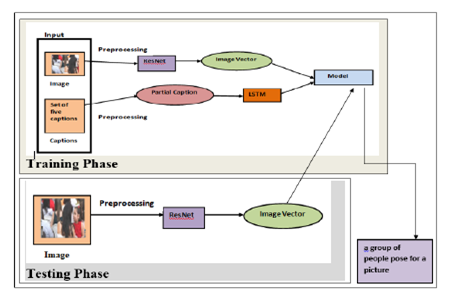 Human beings can describe scenarios and objects in a picture through vision easily, whereas performing the same task with a computer is a complicated one. Generating captions for the objects of an image helps everyone to understand the scenario of the image in a better way. Instinctively describing the content of an image requires the apprehension of computer vision as well as natural language processing. This task has gained huge popularity in the field of technology, and there is a lot of research work being carried out. Recent works have been successful in identifying objects in the image but are facing many challenges in generating captions to the given image accurately by understanding the scenario. To address this challenge, we propose a model to generate the caption for an image. Residual Neural Network (ResNet) is used to extract the features from an image. These features are converted into a vector of size 2048. The caption generation for the image is obtained with Long Short-Term Memory (LSTM). The proposed model was experimented with on the Flickr8K dataset and obtained an accuracy of 88.4%. The experimental results indicate that our model produces appropriate captions compared to the state of art models.
Human beings can describe scenarios and objects in a picture through vision easily, whereas performing the same task with a computer is a complicated one. Generating captions for the objects of an image helps everyone to understand the scenario of the image in a better way. Instinctively describing the content of an image requires the apprehension of computer vision as well as natural language processing. This task has gained huge popularity in the field of technology, and there is a lot of research work being carried out. Recent works have been successful in identifying objects in the image but are facing many challenges in generating captions to the given image accurately by understanding the scenario. To address this challenge, we propose a model to generate the caption for an image. Residual Neural Network (ResNet) is used to extract the features from an image. These features are converted into a vector of size 2048. The caption generation for the image is obtained with Long Short-Term Memory (LSTM). The proposed model was experimented with on the Flickr8K dataset and obtained an accuracy of 88.4%. The experimental results indicate that our model produces appropriate captions compared to the state of art models. - Reservation for Communities in Sikkim: Examining the Political Demand January 27, 2023
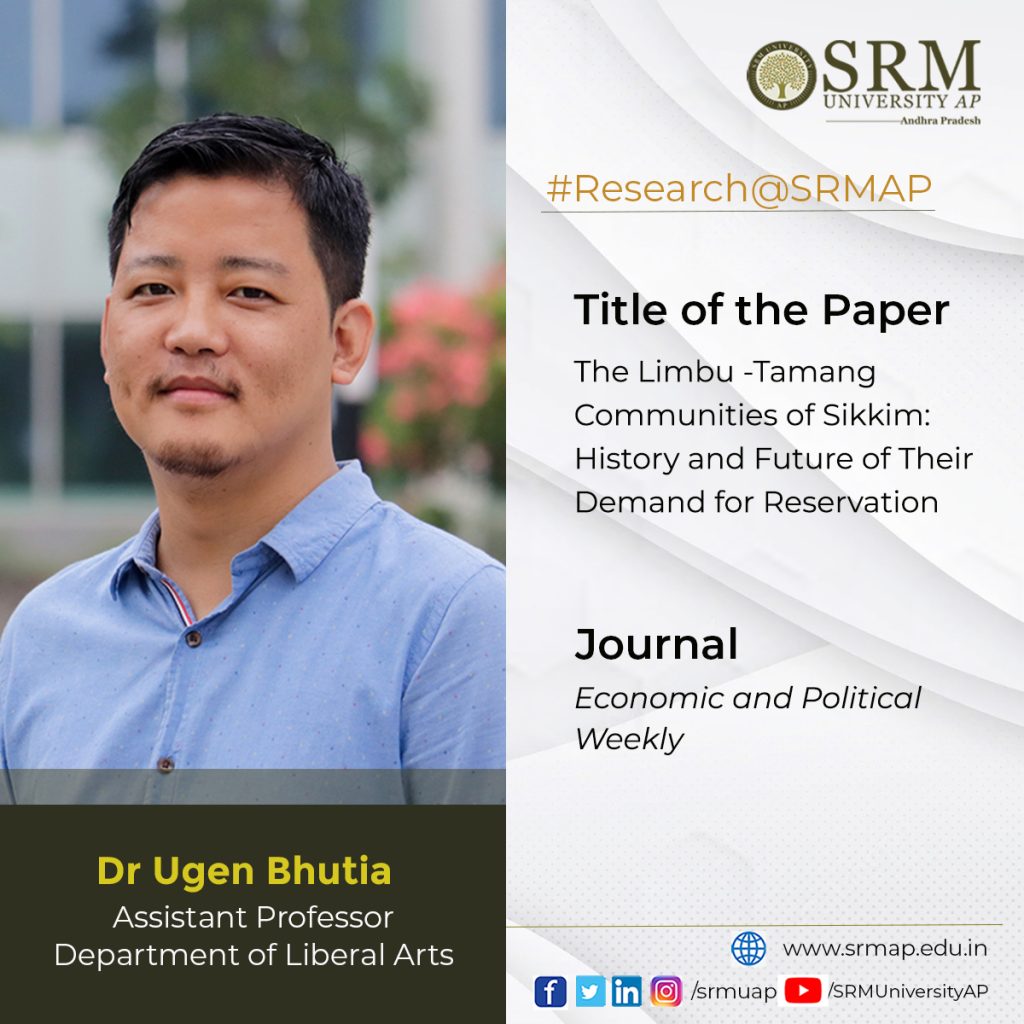 It is a prerequisite for a country like India showcasing vast cultural, social, political and economic diversity, for adopting an unprejudiced reservation system to ensure equal and just representation of varied communities in the political decision-making process of the country. But many communities that have been historically disadvantageous(SC/ST) still struggle to receive their right to representation. Dr Ugen Bhutia, Assistant Professor, Department of Liberal Arts, has published a paper titled “The Limbu–Tamang Communities of Sikkim History and Future of Their Demand for Reservation” in the Journal Economic and Political Weekly. The paper provides a comprehensive outlook on the complex history of the communities in Sikkim and past events that have cumulated in their demand for representation in the democratic polity of the country. The future direction of the demand for reservation and its prospective outcomes have also been emulated.
It is a prerequisite for a country like India showcasing vast cultural, social, political and economic diversity, for adopting an unprejudiced reservation system to ensure equal and just representation of varied communities in the political decision-making process of the country. But many communities that have been historically disadvantageous(SC/ST) still struggle to receive their right to representation. Dr Ugen Bhutia, Assistant Professor, Department of Liberal Arts, has published a paper titled “The Limbu–Tamang Communities of Sikkim History and Future of Their Demand for Reservation” in the Journal Economic and Political Weekly. The paper provides a comprehensive outlook on the complex history of the communities in Sikkim and past events that have cumulated in their demand for representation in the democratic polity of the country. The future direction of the demand for reservation and its prospective outcomes have also been emulated.Abstract
Since its merger in 1975 with the Indian union, one of the major sociopolitical issues in Sikkim has been the demand for reservation in the state legislative assembly for two communities—Limbu and Tamang. The demand of reservation for the Limbus and Tamangs crystallised in Sikkim when these communities were notified as Scheduled Tribes under the Scheduled Castes and Scheduled Tribes Orders (Amendment) Act, 2002. The history and future of this political demand has been analysed.
Continue reading → - Kudos to our Champions! – Silver Medal at Volleyball Championship January 20, 2023
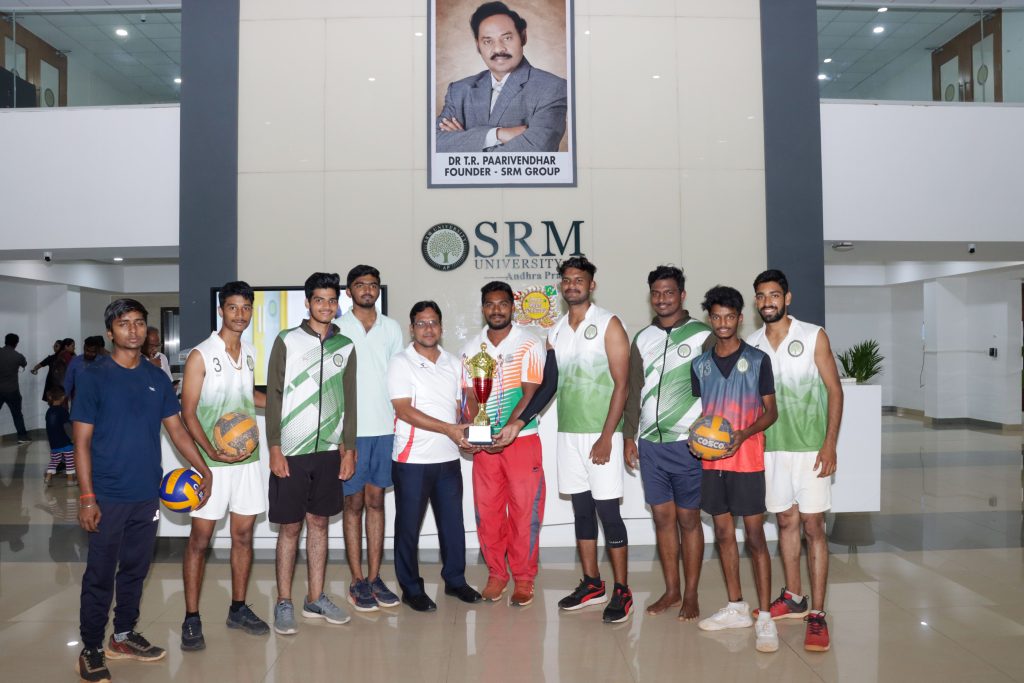 The joyful bliss when you reap the fruits of your labour and passion is immeasurable! The Directorate of Sports proudly congratulates the Men’s Volleyball team for bagging the Silver Medal in the Andhra Pradesh and Telangana State-level Institutional Volleyball Championship held at Khammam, Telangana. The league tournament was held from January 13 to 15, 2023 and was sponsored by Techwave India Ltd. The Volleyball team displayed a fantastic performance throughout the league and furnished a grand victory over the Khammam team in the semifinals by 3-2 sets. Dr Vijay Kumar Upadhyay, Ex-Ranji Player and Director of Sports, SRM AP was the Chief Guest of the Tournament.
The joyful bliss when you reap the fruits of your labour and passion is immeasurable! The Directorate of Sports proudly congratulates the Men’s Volleyball team for bagging the Silver Medal in the Andhra Pradesh and Telangana State-level Institutional Volleyball Championship held at Khammam, Telangana. The league tournament was held from January 13 to 15, 2023 and was sponsored by Techwave India Ltd. The Volleyball team displayed a fantastic performance throughout the league and furnished a grand victory over the Khammam team in the semifinals by 3-2 sets. Dr Vijay Kumar Upadhyay, Ex-Ranji Player and Director of Sports, SRM AP was the Chief Guest of the Tournament.The team consisted of Captain – Ch Ganesh TVM Sai; Vice Captain – Ch Srinivas Rao and members N Gnana Sai Kiran, K Vivek, K Niranjan, K Bhardwaj, S Yeswanth, K Bhuvenesh, N Mahmood, K J N Venkat Sai, K Avinash, K Shri Harsha, K Balaji. They were accompanied by Coach – Tella Vamsi and Manager – Dr Abdul Mohimin.
SRM AP provides top-notch training and world-class facilities for students with potential, building them into national and international athletes. The university also celebrates the amalgamation of sports with academics improving the physical and mental constitution of the students. The university also recognises the need to provide aspiring athletes with opportunities to receive premier education. Hence the institute plans to include Sports and NCC Quota in the University Admissions in the upcoming year.
Continue reading → - Innovative University of the Year 2022: SRM University-AP bestowed with the title of honour January 17, 2023
 SRM University-AP has been crowned as Innovative University of The Year -2022 by Academic Insights Magazine in recognition of the commendable contributions the university has made towards society and the educational fellowship. This title of honour is an annual recognition programme for private universities, which have stood out among the rest in the previous year in imbibing students with quality education and ethical values.
SRM University-AP has been crowned as Innovative University of The Year -2022 by Academic Insights Magazine in recognition of the commendable contributions the university has made towards society and the educational fellowship. This title of honour is an annual recognition programme for private universities, which have stood out among the rest in the previous year in imbibing students with quality education and ethical values.SRM University-AP has been embodying absolute innovation across all the disciplines and schools of the university, which is a laudable quality among the new-age universities of the country. Universities vary widely in their innovation maturity levels, and there is a substantial knowledge and experience gap within and across institutions. SRM AP is credited as the notable exception for the pathbreaking innovations made in the higher education sector. The editorial team at The Academic Insights has conducted rigorous research on various factors to choose the university of the year, with many universities participating yearly.
Continue reading → - A Critical Analysis of Solid Waste Microplastics January 10, 2023
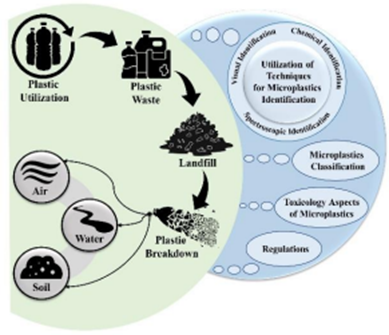
Solid waste is primarily an overlook source of Microplastics that contribute to a delirious amount of pollution to the environment. Thus, a clear understanding of the occurrence and degradation pathways of solid waste microplastics is critical to develop exhaustive control strategies. Dr Deblina Dutta, Assistant Professor, Department of Environmental Science, has published a paper titled, “An insight on sampling, identification, quantification and characteristics of microplastics in solid wastes” in the Q1 journal Trends in Environmental Analytical Chemistry, having an Impact Factor of 13.62.
Abstract of the Research
Microplastics (MPs) have attracted wide attention worldwide as a remarkable pollutant. While MPs spread throughout several complex environmental matrices, various experiments have been preliminarily concentrated on aquatic ecosystems. Terrestrial sources namely solid waste-origin have remained unexplored, although they contribute largely to the origin of aquatic microplastics. Simultaneously, terrestrial systems under human activity, like healthcare units, are likely to be polluted by various plastic ingredients. Solid waste MPs sources primarily include sanitary landfilling, food waste, wastewater treatment end-product (sludge), tire wear, textile washing and paint failure. These microplastics cause adverse impacts on the ecosystem, environment, and health. Accordingly, the present study addressed solid waste MPs’ occurrence and sources, identification, quantification, characterisation, fate, and degradation pathways for developing comprehensive management strategies following the principles of a circular economy.
In particular, this paper critically demonstrated solid waste MPs sources, solid waste MPs sampling followed by identification and quantification by adopting combined chemical (e.g., spectroscopy viz., Fourier transform infrared (FTIR) spectroscopy, and Raman spectroscopy), physical (e.g., microscopies such as transmission or scanning electronic microscopy, TEM or SEM) and thermal analyses. Additionally, the strengths and limitations of each analytical technique are discussed critically with practical aspects. Further, national and international regulations or laws and their subsequent relevance to solid waste MPs management with future challenges are critically discussed. Finally, the outcomes of the review paper will be valuable to different stakeholders for effective policy implementation.
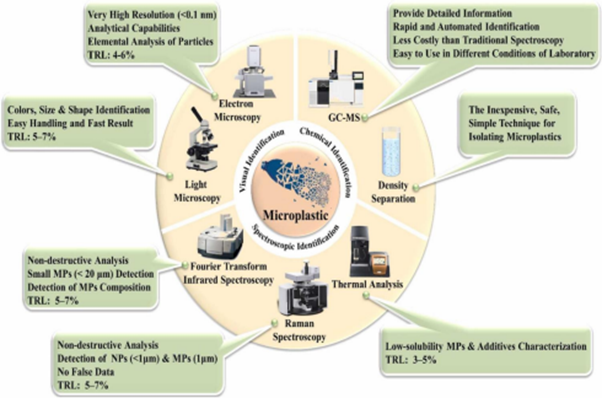
Explanation of the Research in Layperson’s Terms
The published paper deals with microplastics (5 mm to 0.1 μm in size) present ubiquitously in the natural environment including rivers, lakes, estuaries, atmosphere, oceans, soil/sediments, landfilling sites, and wastewater treatment plants. However, microplastics are also present in solid waste and studies related to their identification, characterisation, and quantification are very scarce. Therefore, to know more about microplastics and understand the sources of microplastics in solid waste, the extraction procedures, the identification, characterisation, and quantification techniques, and finally the advantages and disadvantages of each of the processes involved in the identification, characterization, and quantification techniques of microplastics, this study has been carried out.
Practical Implementation/ Social Implications of the Research
Waste-assisted plastic pollution is a major global concern with socio-economic, ecological, and health effects. The present study will make society understand the source of microplastics in solid waste along with its extraction procedures, identification, characterisation, and quantification techniques. If society is aware of the adverse effects of microplastics, then only one can think to protect the environment and human health.
Collaborations
The research has been carried out in collaboration with the University of Burdwan, the University of North Bengal, and CSIR-NEERI, Nagpur.
It is now widely recognised that microplastic pollution poses a serious threat to the environment on a global scale. Having originated from a diverse source, it has persisted in various ecosystems, thereby entering the trophic chain. It has contributed to microplastic pollution in the environment, e-waste being a major source of it. Hence, along with metal recovery from e-waste, regulating microplastic pollution is a growing interest. At this juncture, Dr Dutta’s future research is directed towards resource recovery processes, regulating microplastic pollution, risk assessment, life cycle assessment, and techno-economics analysis.
Continue reading → - IEEE SPS Winter School on Deep Learning for Image Restoration and Computer Vision January 6, 2023
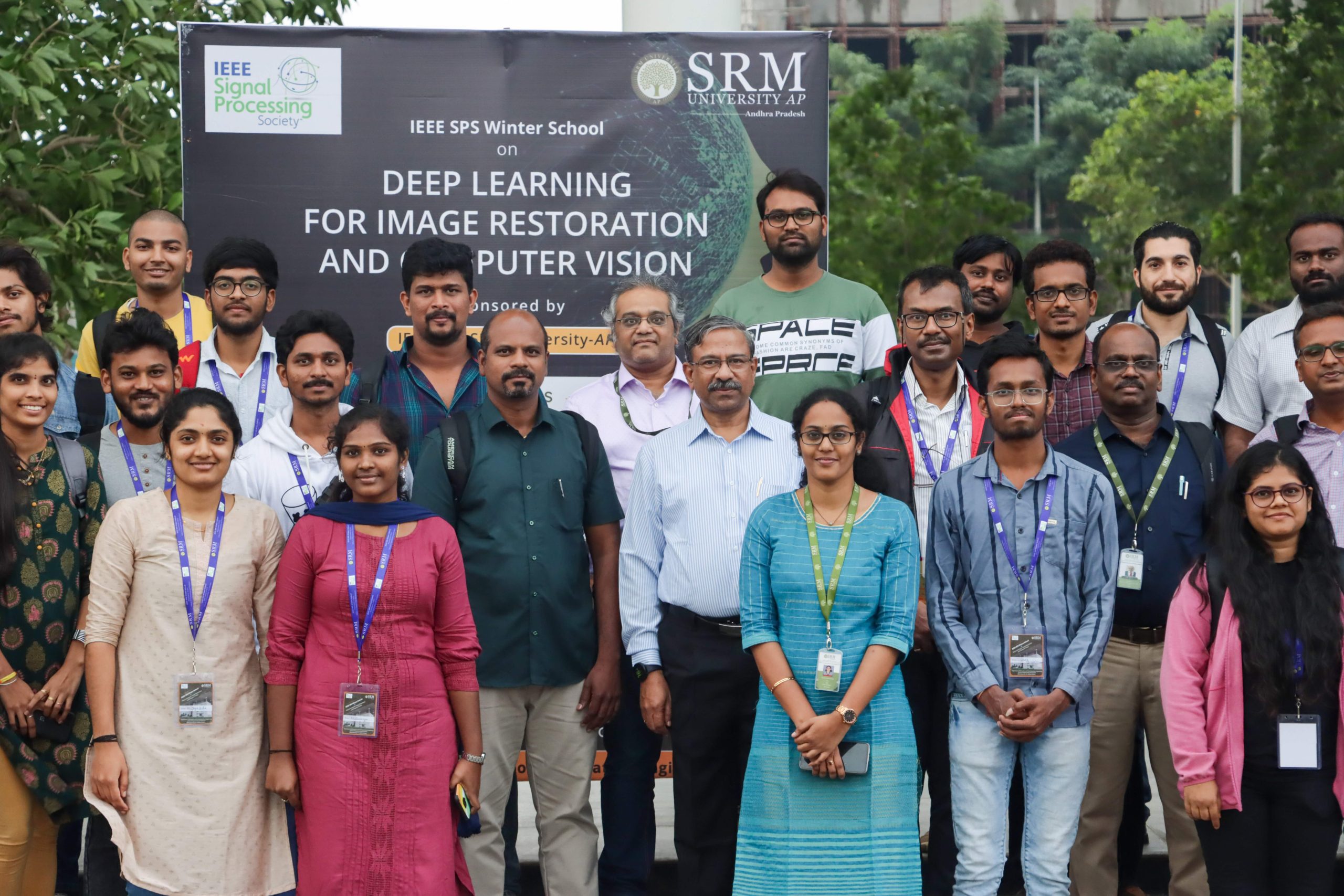 SRM University-AP hosted the IEEE SPS Winter School on Deep Learning for Image Restoration and Computer Vision from December 5 to 10, 2022. The six-day conference organised by the Department of Electronics and Communication Engineering was inaugurated by the honourable Pro-Vice-Chancellor of SRM University-AP, Prof. D Narayana Rao. Expert talks by renowned academicians from the University of Dayton, USA; University of Bath, UK; IIT Hyderabad; IISc Bangalore; IIIT Hyderabad; DA-IICT etc., were the highlights of the conference.
SRM University-AP hosted the IEEE SPS Winter School on Deep Learning for Image Restoration and Computer Vision from December 5 to 10, 2022. The six-day conference organised by the Department of Electronics and Communication Engineering was inaugurated by the honourable Pro-Vice-Chancellor of SRM University-AP, Prof. D Narayana Rao. Expert talks by renowned academicians from the University of Dayton, USA; University of Bath, UK; IIT Hyderabad; IISc Bangalore; IIIT Hyderabad; DA-IICT etc., were the highlights of the conference.Prof. Sumantra Dutta Roy from IIT Delhi, a well-acclaimed researcher in computer vision and machine learning, joined on the last day of the conference, Saturday, December 10, 2022, for a lecture on Biometrics and Medical Informatics. The discourse focused on the speaker’s struggles to come to terms with concepts which have comparatively little physical significance in terms of mathematical rigour or algorithmic efficiency but have the potential to produce hitherto unseen levels of startling results. The talk concluded with some applications of deep architectures and a few problems in biometrics and medical informatics.
The event was funded by IEEE and guided by the IEEE Guntur subsection and Hyderabad Section. Hands-on sessions were also conducted at the conference. Faculty, researchers, and students from various universities around the map participated in the insightful sessions. The event organisers were Prof. Jiji CV and Assistant Professor Dr Sateeshkrishna Dhuli of the Department of Electronics and Communication Engineering, SRM University-AP.
Continue reading → - Young Researcher Award 2022 January 2, 2023
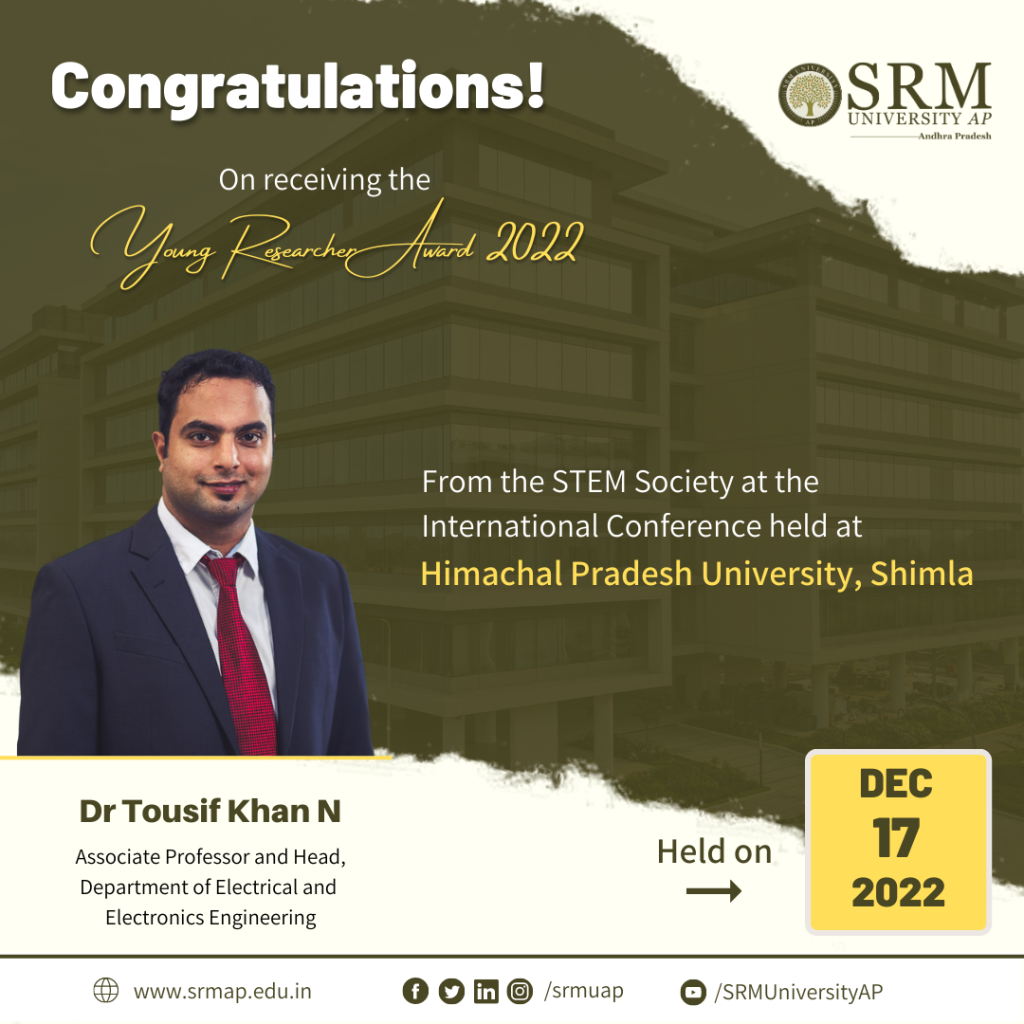
Dr Tousif Khan, Associate Professor and Head, Department of Electrical and Electronics Engineering has been awarded the “Young Researcher Award 2022” by the STEM Society at the International Conference organised at Himachal Pradesh University, Shimla on December 17, 2022. The basic purpose of the STEM-RS is to bring together Researchers, Academicians, Industrialists and Experts from different parts of the country and the world, to exchange knowledge and breakthrough ideas at a common platform by organising national and international events such as Conferences, Seminars and Workshops that unite the Science, Technology, Engineering and Management for the empowerment of research and development.
Continue reading → - Aadigyan-Indian Immersion Programme for Students of UTP Malaysia December 28, 2022
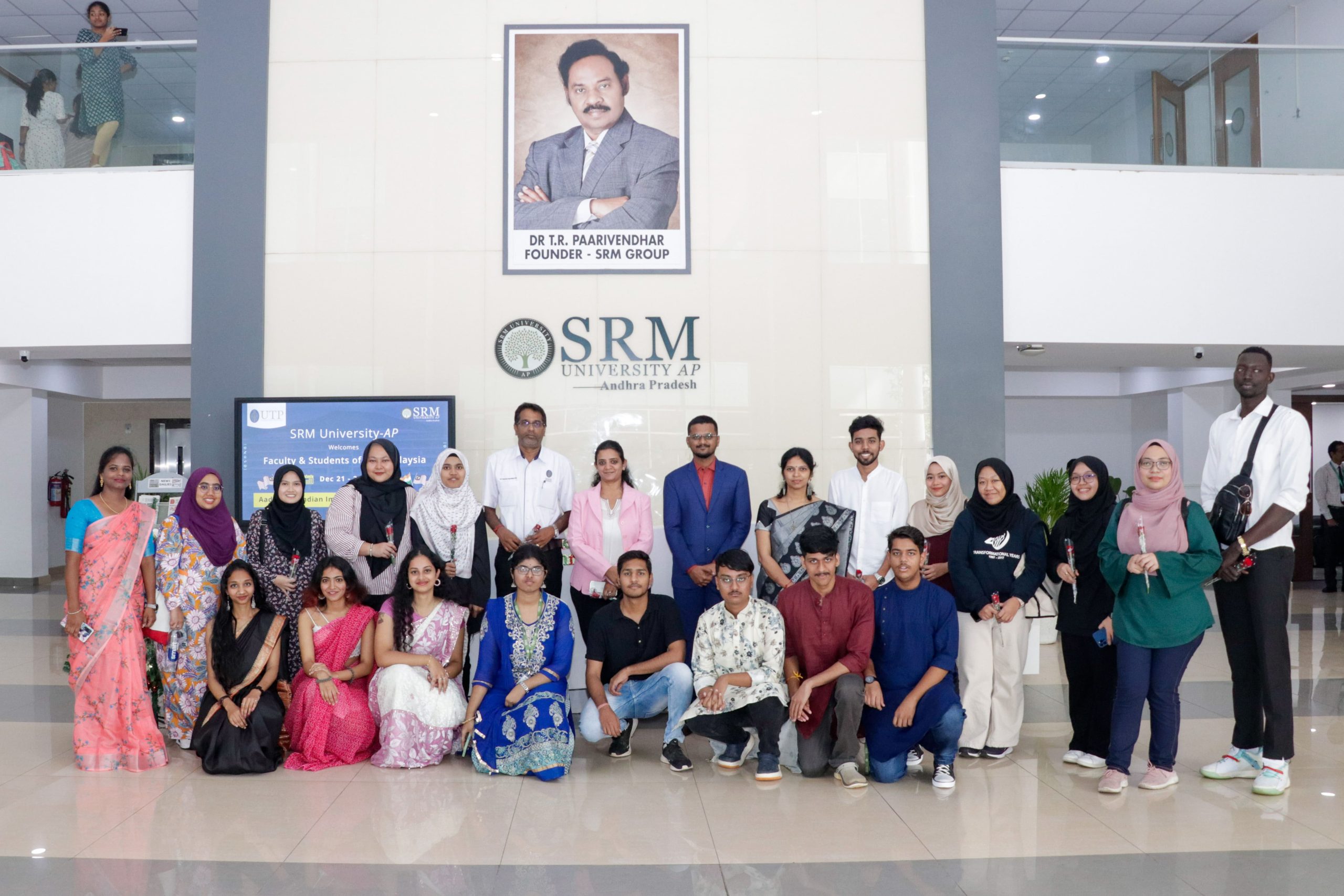 SRM University-AP welcomed the students and faculty of the Universiti Teknologi PETRONAS (UTP), Malaysia, to the rich cultural landscape of India through the Aadigyan-Indian Immersion programme 2022. The one-week-long programme conducted by the Directorate of International Relations and Higher Studies was inaugurated by the honourable Vice Chancellor of SRM University-AP, Prof. Manoj K Arora. Aadigyan is a flagship initiative of the university to promote India’s cultural and knowledge traditions.
SRM University-AP welcomed the students and faculty of the Universiti Teknologi PETRONAS (UTP), Malaysia, to the rich cultural landscape of India through the Aadigyan-Indian Immersion programme 2022. The one-week-long programme conducted by the Directorate of International Relations and Higher Studies was inaugurated by the honourable Vice Chancellor of SRM University-AP, Prof. Manoj K Arora. Aadigyan is a flagship initiative of the university to promote India’s cultural and knowledge traditions.Dr Naga Swetha Pasupuleti, Associate Director of the Directorate of International Relations and Higher Studies, received the international students at the grand inaugural ceremony of the programme. Students participated in various short courses on Data Analysis, Samaj Seva, the Art of Negotiation & Digital Marketing offered by the Paari School of Business. They also got to visit the famous landmarks of Vijayawada, such as the Dhyana Buddha statue, Prakasham Barrage, Kondapalli, etc. The traditional toy-making practice enticed the Malaysian student cohort.
Students interacted with many industry experts as they visited Infosys Gachibowli, Hyderabad campus, which gave them insights regarding the current trends and new technologies. The programme also included interaction with the 160+ International students of SRM AP from more than 29 countries over RRR Movie Screening and Gala Night. The programme ended on December 26, 2022, with a valedictory session and facilitating faculty and students of UTP Malaysia.
Continue reading → - Industrial Visit to MEIL December 27, 2022
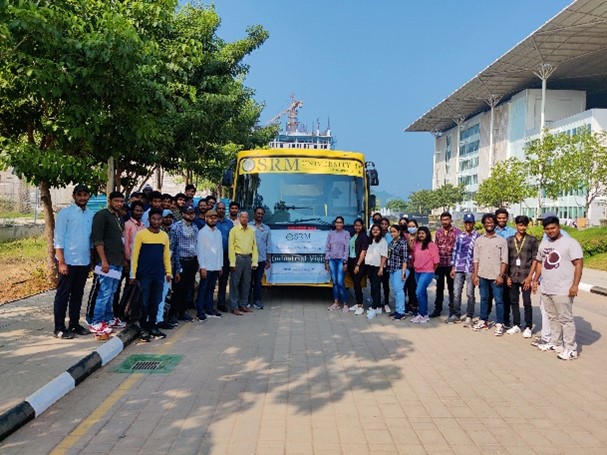
The Department of Civil Engineering has organised an industrial visit to Megha Engineering & Infrastructure Limited (MEIL) for engineering students to harbour them with the practical skillsets demanded by profession. The field visit was guided by senior engineers working on respective sites and co-ordinated by the faculty.
Project: Six-Laning of Vijayawada Bypass from Chinna Autupalli (Design Ch. 0.000) to Gollapudi (Design Ch. 30.000) Section of NH-16
Construction Company: Megha Engineering & Infrastructures Limited (MEIL)
Visit Highlights:
- Safety training by MEIL
- Quality Control Lab tour
- Soil, Aggregate, Bitumen, and Cement Concrete Testing
- Quality Control Aspects
- Batching Plant visit
- WMM and Concrete batching plants
- Site Tour
- Earthworks, Embankment, and WMM Construction
Coordinating faculty: Dr A Uma Maheswar
Continue reading →

